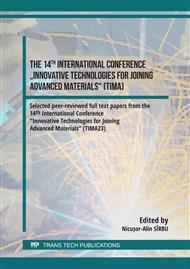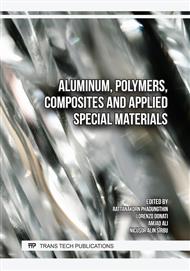p.29
p.37
p.43
p.53
p.61
p.69
p.77
p.83
p.91
Research on the Cavitation Resistance Testing of Friction Stir Welded Joint of En Aw 1200 Aluminium Alloy
Abstract:
Aluminium alloys are being used more often as a result of industry demands for strong, lightweight materials. Because of its advantages over conventional fusion welding techniques, friction stir welding, or FSW, has become a promising technique for joining aluminium alloys. Nonetheless, there is still cause for concern regarding FSW joints' vulnerability to cavitation erosion, which is a major issue in applications exposed to harsh environments. The cavitation resistance of EN AW 1200 aluminium alloy joints made by the FSW process is the main objective of this study. By utilizing specialized equipment to conduct cavitation tests, the study uses a comprehensive methodology to assess the cavitation erosion behaviour of these joints. A number of variables are investigated in order to determine how they affect the cavitation resistance of the welded joints, including mechanical attributes, welding parameters, and microstructural features. The goal of the study is to shed light on how well FSW joints function and hold up in cavitation scenarios. This information will be useful in improving the dependability and suitability of EN AW 1200 aluminium alloy in sectors where the ability to withstand cavitation erosion is critical. The findings from this study are expected to contribute to the optimization of welding parameters and material selection, ultimately advancing the use of aluminium alloys in critical applications requiring resistance to cavitation-induced damage.
Info:
Periodical:
Pages:
91-96
Citation:
Online since:
October 2024
Keywords:
Price:
Сopyright:
© 2024 Trans Tech Publications Ltd. All Rights Reserved
Share:
Citation:



